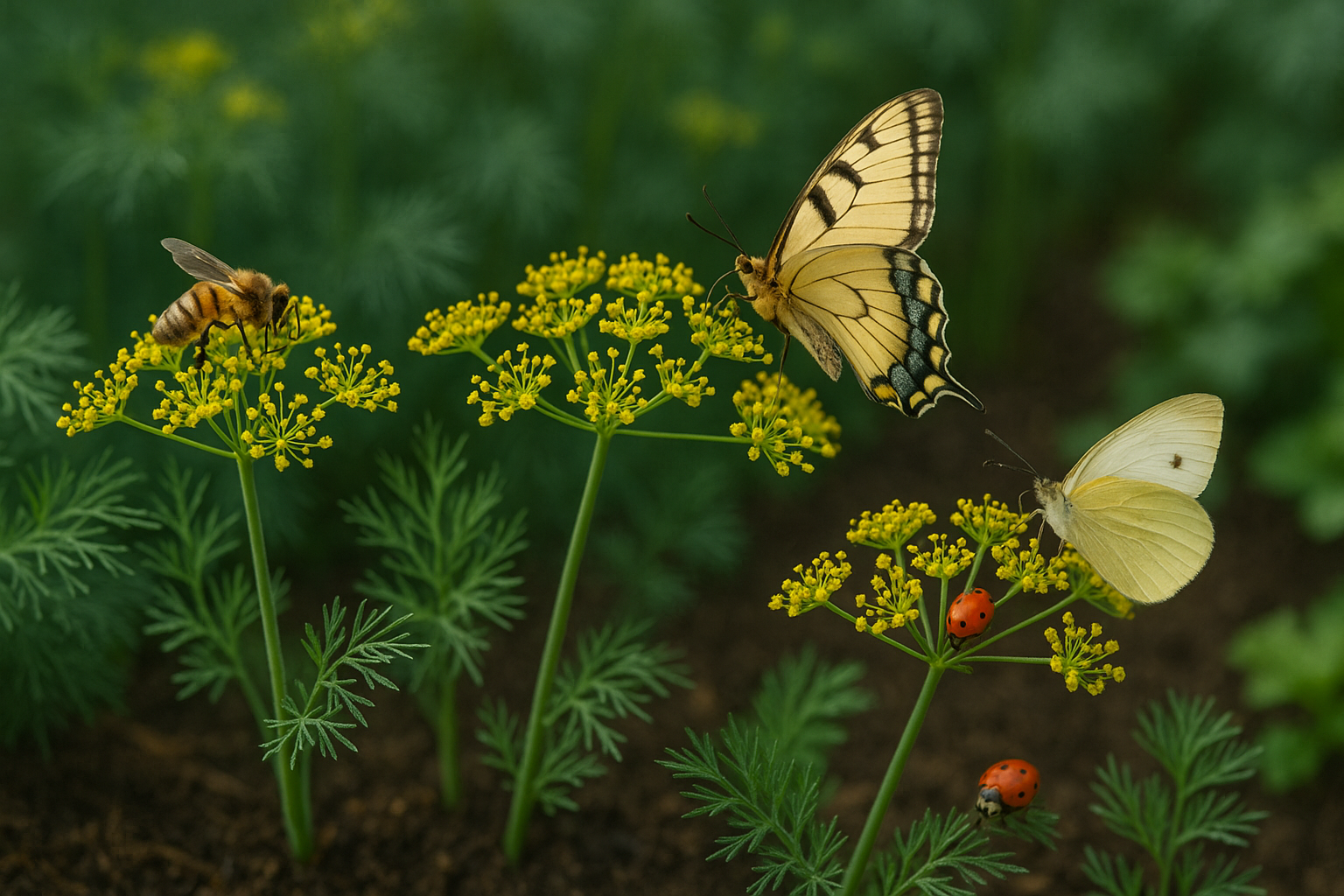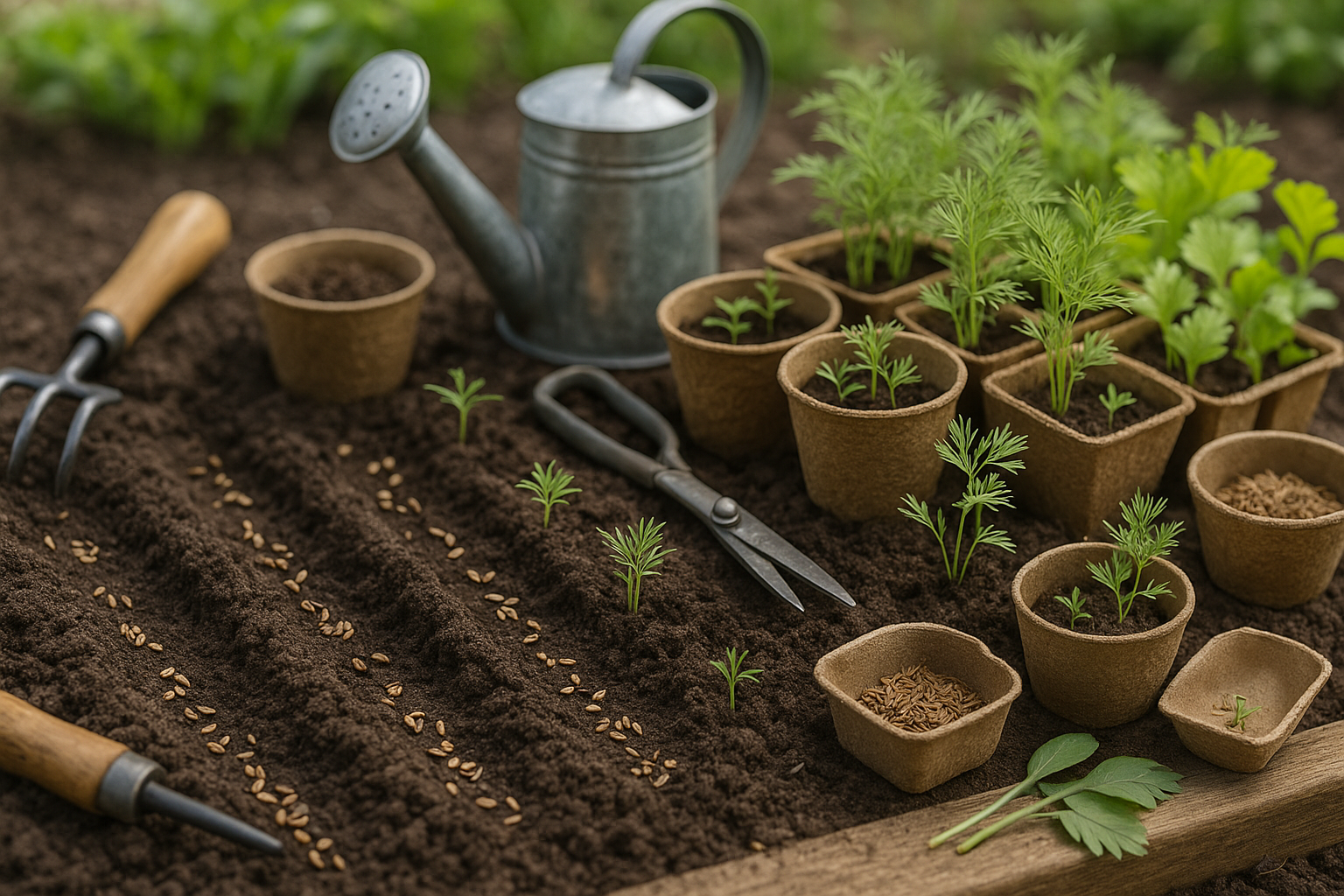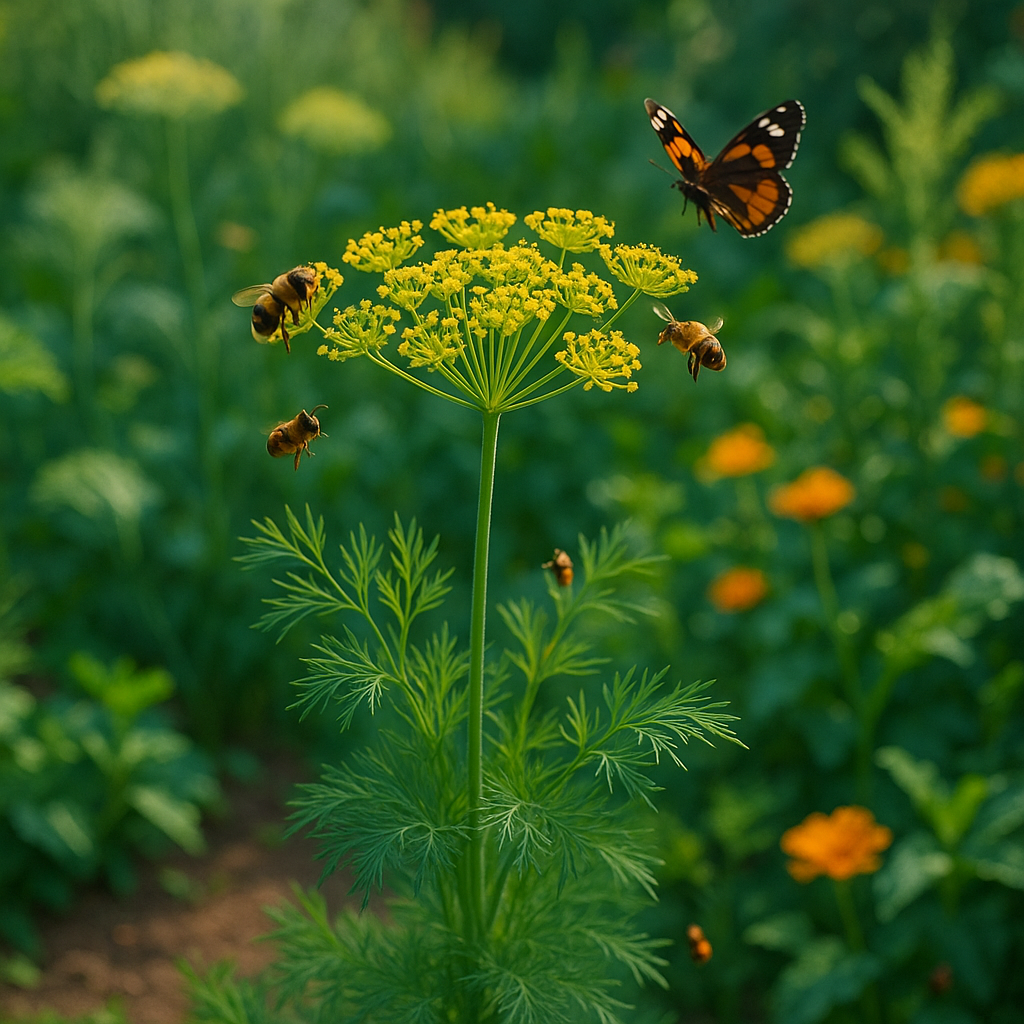Why Grow Dill for Pollinators and Beneficial Insects?

Dill isn’t just a kitchen staple—it’s also a powerhouse for promoting a thriving, balanced garden. As an herb, dill is easy to grow, thriving in both beds and containers, but its real magic lies in the way it transforms your outdoor space into a hotspot for pollinators and beneficial insects.
Healthy gardens rely on these tiny helpers: bees and butterflies transport pollen between flowers, ensuring fruits and veggies set properly, while beneficial insects like ladybugs and lacewings keep pests in check by feeding on aphids and mites.
Dill’s clusters of delicate yellow flowers, known as umbels, act as a beacon for insects thanks to their rich nectar and pollen supply. Bees are drawn to the easy-access flowers, while butterflies seek them out as a nourishing nectar source. Even more, the feathery foliage provides a perfect hiding spot for ladybug larvae and predatory wasps, both notorious for their effective pest control.
In fact, observational studies and gardening reports repeatedly show that plantings of dill attract significantly more pollinator visits compared to similar herbs without umbels, such as basil or sage. A quick glance at any dill patch in peak bloom will likely reveal not only bees and butterflies but a bustling microcosm of lacewings, hoverflies, and even helpful predatory beetles.
By choosing to grow dill, you’re not only enriching your meals—you’re making a conscious choice to support pollinator populations and build natural resilience into your garden. This small addition can lead to a visible increase in flower and crop yields, all while lessening the need for chemical pest controls, making it a smart, sustainable choice for gardeners of every level.
Choosing the Right Dill Variety for Your Garden
When selecting the best dill variety for your garden, consider how each type differs in growth habit, flavor, and usefulness in attracting beneficial insects.
“Bouquet” dill is probably the most popular choice for home gardens; it grows tall and produces large, umbrella-like flower heads that are magnets for pollinators like bees and predatory insects such as ladybugs, which help control pests naturally.
If you’re working with smaller garden beds or containers, opt for “Fernleaf,” a compact, bushy variety bred specifically for limited spaces. While its feathery leaves make it an attractive border plant, it still produces enough flowers to draw in helpful insects.
Gardeners in cooler climates might prefer “Superdukat,” known for its extra-dark foliage and tolerance to temperature fluctuations, making it reliable in unpredictable weather.
For warm, humid regions, look for bolt-resistant types like “Long Island Mammoth,” which stay productive even as temperatures rise.
When sourcing seeds or young plants, visit your local garden centers, farmers’ markets, or reputable seed banks—these trusted sources often carry organic or untreated seed options, reducing the risk of chemical contaminants.
Choosing organic seed is especially important if you want to avoid introducing pesticides into your ecosystem and ensure your dill is truly safe for both pollinators and people. Always check product details or ask the seller for pesticide-free options, and look for third-party organic certifications if you’re committed to natural gardening practices.
Ultimately, matching the right dill variety to your garden’s needs can boost biodiversity, add fresh flavor to your kitchen, and support a healthier environment.
How to Plant and Grow Healthy Dill

To plant and grow healthy dill, start by choosing the right time—dill thrives when sown in early spring once the danger of frost has passed, or again in late summer for a fall harvest. Select a spot with full sun, as dill loves at least 6 to 8 hours of sunlight daily, and prepare well-draining soil rich in organic matter. Dill does best in slightly acidic to neutral pH (6.0–7.0).
For direct sowing, scatter seeds thinly over prepared soil and cover lightly (about 1/4 inch deep), keeping rows about 12 inches apart. Water gently to keep the soil moist until seeds sprout in about 10–14 days.
If starting indoors, sow seeds in biodegradable pots 2–4 weeks before the last frost, then transplant the seedlings outdoors after all threat of frost, taking care not to disturb their delicate roots—plant the whole pot if possible.
If you’re working with limited space or growing on a balcony, dill grows well in containers at least 12 inches deep. Just ensure the pot drains well and turn the pot occasionally for even sun exposure.
Mulch around plants to retain moisture and suppress weeds, but avoid chemical herbicides or pesticides—dill attracts beneficial pollinators like bees and ladybugs. Organic methods like hand-pulling weeds and using neem oil for pest control are best.
Pinch back flower heads if you want bushier plants, or allow some to bloom and set seed if you’d like to harvest seeds for cooking.
With these steps and a commitment to organic gardening, you’ll have a robust, pollinator-friendly dill harvest even in small spaces.
Maximizing Dill’s Appeal to Pollinators and Beneficial Insects
Dill is a magnet for a variety of pollinators and beneficial insects, making it a valuable addition to any garden ecosystem. The umbrella-shaped clusters of tiny yellow flowers, called umbels, are especially alluring to bees, hoverflies, parasitic wasps, and ladybugs.
Bees are drawn to the rich source of nectar and pollen, while hoverflies and parasitic wasps are attracted by the easy access to food and places to lay eggs—both contribute significantly to natural pest control. Ladybugs flock to dill to hunt aphids, helping to keep your garden naturally balanced.
Dill’s flowers typically bloom in late spring through summer, offering a vital food resource at times when other blooms may be scarce. Giving dill a sunny spot in your garden maximizes its nectar production and ensures healthy, robust plants.
For best results, let some dill plants fully mature and flower rather than harvesting all of them. This not only extends the bloom period but also boosts the diversity of visiting insects.
To further increase garden biodiversity and beneficial insect traffic, plant dill alongside other nectar-rich companions like fennel, coriander, calendula, and alyssum. These plants blossom at different times and heights, creating staggered sources of food and shelter.
Grouping dill and its companions in sunny, open areas avoids overcrowding and makes it easier for insects to find the plants. By thoughtfully placing and pairing dill with complementary flowers, you create a thriving refuge for pollinators and natural pest controllers—ultimately resulting in healthier gardens and more abundant harvests.
Ongoing Care and Troubleshooting for a Pollinator-Friendly Dill Patch
Maintaining a pollinator-friendly dill patch is easy with a few simple, mindful habits. Begin by watering dill consistently but sparingly—dill thrives in well-drained soil and is fairly drought-tolerant, so it’s better to let the top inch of soil dry out between waterings.
Regularly thin out crowded seedlings to prevent fungal issues and allow enough airflow, which helps the plants grow strong without chemical intervention. Feeding your dill with compost or diluted fish emulsion a couple of times over the growing season can boost growth without jeopardizing beneficial insects. Avoid synthetic fertilizers, as these can harm delicate pollinator communities.
Keep an eye out for common pests like aphids and caterpillars. Try gently rinsing them off with water or introducing companion plants like marigolds to deter invaders naturally. If you spot powdery mildew or other diseases, remove affected leaves promptly and ensure the patch isn’t overcrowded. Always opt for organic controls like neem oil, used sparingly, and never apply anything during peak pollinator activity.
An essential tip: avoid over-harvesting your dill, especially flower heads, as they are a favorite food source for bees, butterflies, and helpful wasps. Let a portion of your dill mature and bloom to keep your pollinators well-fed.
Remember, a successful pollinator habitat relies on chemical-free care—embrace hand-picking, physical barriers, and organic methods to keep your dill patch and its buzzing visitors happy and healthy all season long.
Harvesting Dill Without Harming Pollinators or Beneficial Insects
When harvesting dill, it’s important to balance enjoying your fresh herbs with supporting pollinators like bees and butterflies. To keep your dill patch thriving and friendly to beneficial insects, try selective, staggered harvesting.
Instead of taking large portions all at once, snip only a few leaves from each plant, focusing on the outermost stems and leaving the flower heads intact. This approach lets you enjoy plenty of fresh foliage for cooking while still providing blooms that attract pollinators.
When it’s time to harvest seeds, wait until some of the flower heads have started to dry and turn brown, but don’t remove all of them—leave a few standing to continue offering nectar and, later, seeds for birds and insects.
If you want a steady supply of dill and ongoing pollinator support, allow some plants to self-seed by letting the seeds fall naturally. This not only reduces your planting work the next season but also creates a habitat that helps pollinators year-round.
Consider harvesting in the cooler early morning or later evening, when pollinator activity is lowest, to minimize disturbance. By rotating your harvests and leaving flowers to feed visiting pollinators, you ensure a healthy garden ecosystem while still enjoying everything dill has to offer.
These mindful practices mean you’ll support biodiversity, see more beneficial insects in your garden, and reap repeated harvests throughout the growing season.
Creating a Pollinator Paradise
Transforming your garden into a pollinator paradise starts with thoughtful plant selection and clever design. Dill acts as a magnet for beneficial insects like ladybugs and hoverflies, but it truly shines when paired with other pollinator-friendly herbs and flowers.
Consider grouping dill with basil, fennel, and borage—all of which not only attract bees and butterflies but also offer culinary uses for your kitchen. Flowers such as cosmos, zinnias, echinacea, and coreopsis scattered throughout your garden add visual interest while drawing in a diverse array of pollinators.
To maximize insect activity, arrange your plants in clusters or drifts rather than single rows. This concentrated planting style creates pollinator “hot spots” that are easier for insects to locate. Layering plants by height—from low-growing thyme and oregano to medium-height dill and tall sunflowers—provides shelter and varied feeding opportunities for bees, butterflies, and even hummingbirds.
Don’t shy away from leaving a few wild corners or patches of native wildflowers; these undisturbed spaces offer essential nesting and overwintering sites for solitary bees and other helpful insects.
To deepen your knowledge, explore local gardening workshops or join online communities like the Xerces Society or Pollinator Partnership. Many neighborhoods also host pollinator garden tours or seed swaps, making it easy to get involved, exchange tips, and build a supportive network for sustaining a healthier, buzzing landscape.
